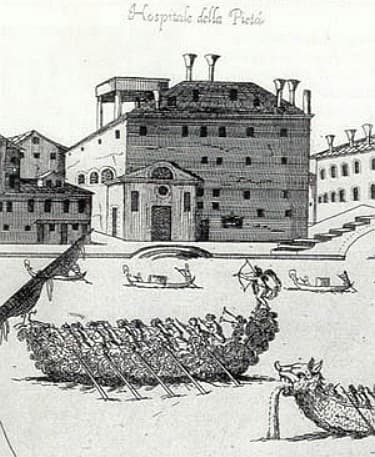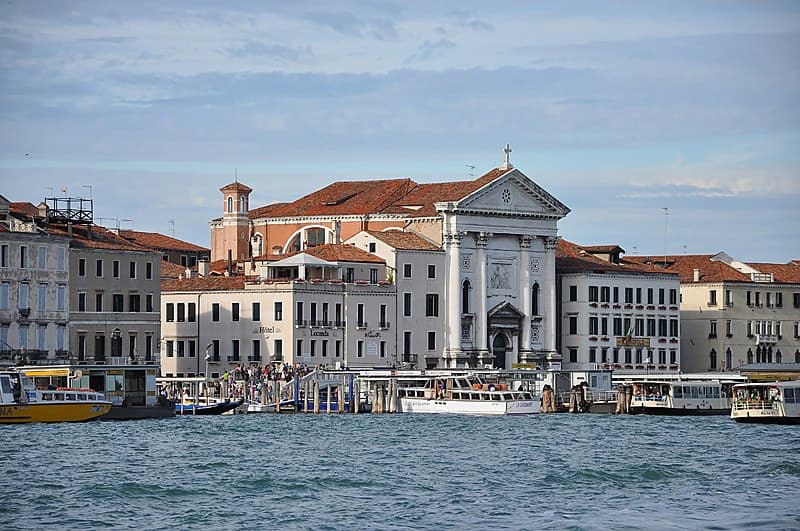The city of Venice underwent a fundamental transformation towards the end of the 17th century. For centuries Venice had wielded considerable economic powers based on the manufacturing of textiles and from trade with Europe and Asia. Gradually, however, culture became her most characteristic field of activity, “and like a magnet the city drew visitors in huge numbers from all over Europe, who observed her institutions, admired her buildings, wondered at her ceremonies, thronged to her theatres and gaming houses, and frequently departed with a memento, perhaps a painting or a musical score.”

Antonio Vivaldi, 1723
In terms of painting and music, Venice started to rely on foreign patronage, and a good many articles were seemingly made for export. A scholar writes, “Composers came to put more and more of their efforts into readily exportable types of music, for example, the opera and the concerto at the expense of genres serving local needs.” The church of St Mark’s catered to the ceremonial needs of the city, and the four “ospeddali” (hospitals) were charitable institutions for orphaned, abandoned, illegitimate or indigent children. The city of Venice, it seems, became rather fashionable, and it set the trends for the rest of Europe.
Antonio Vivaldi: Trio Sonata in G minor, Op. 1, No. 1 (Federico Guglielmo, violin; L’Arte dell’Arco)
“I almost always live at home and go out only in a gondola or carriage”

Ospeddale della Pietà
On 6 May 1678 we read in the baptismal register of San Giovanni di Bragora, “Antonio Lucio, son of Signor Giovanni Battista Vivaldi, son of the late Agustin, instrumentalist, and his wife Camilla Calicchio, daughter of the late Camillo, born on 4 March last, who was baptized at home, being in danger of death, by the midwife Madama Margarita Veronese, was today taken to the church and received the exorcisms and holy oils from me, Giacomo Fornacieri, parish priest…” It seems that young Vivaldi was in mortal danger around the time of his birth. That danger is generally considered to have been, what he later describes as “strettezza di petto” (tightness of the chest), possibly a form of bronchial asthma. This particular ailment was to trouble Vivaldi throughout his life, as we read in a resignation letter of 1737. “I have not said Mass for 25 years, nor will I ever again, not because of a ban or an order but from choice, because of an ailment from which I have suffered from birth and by which I am afflicted.” And he later adds, “For this reason, I almost always live at home and go out only in a gondola or carriage, since my chest ailment, or constriction of the chest, prevents me from walking.”
Antonio Vivaldi: Trio Sonata in A Major, Op. 1, No. 9 (Roberto Baraldi, violin; Alberto Martini, violin; Francesco Baroni, clavichord)
Vivaldi’s Musical Talent

Church of the Pietà – Saint Mary of the Visitation
Despite his ailment, young Vivaldi was a precocious musical talent, and he received his first violin instructions from his father, a professional violinist at the church of Santa Cecilia. We have reports that young Vivaldi played on occasion in the orchestra of St Mark’s, but it seems doubtful that he received, as is frequently reported, comprehensive composition lessons from Giovanni Legrenzi, maestro di cappella at St Mark’s. He did, however, receive some instructions in playing the harpsichord. Giovanni Battista and his talented, and subsequently famous son Antonio closely collaborated in musical matters. They travelled widely to perform at assorted church festivals, and in 1729, the pair spent an entire year in Germany. They also became involved in operatic management, operating as co-impresarios during the 1713–14 and 1714–15 seasons at the Teatro Sant’Angelo. In fact, the “hand of Antonio’s principal copyist, from the mid-1710s to the mid-1730s, is believed to be that of his father Giovanni Battista, with whom he shared a succession of apartments in Venice.”
Antonio Vivaldi: Trio Sonata in E Major, Op. 1, No. 4 (Piero Toso, violin; Giuliano Carmignola, violin; Gianni Chiampan, cello; Edoardo Farina, harpsichord; Claudio Scimone, cond.)

Vivaldi’s 12 Trio Sonatas, Op.1
At the age of 15, it was decided that Antonio would be directed toward a career in the priesthood. This decision, as a biographer writes, “was in keeping with his humble origins, and it promised some hope of social mobility.” On 18 September 1693, Vivaldi received his tonsure, and on 23 March 1703, he was ordained as a priest. Vivaldi writes, “Barely ordained a priest, I said Mass for a year or a little longer, and then I abandoned it, having had to leave the altar three times because of the same complaint. Immediately after eating, I can usually move about, but never on foot; this is the reason why I do not celebrate Mass.” It has been suggested that his ailment became a convenient pretext to shift his attention toward the practice and business of music. In the event, “The Red Priest,” started his association with the “Ospeddale della Pietà” in early 1704, and his first publication appeared in or before 1705. Opus 1 is a set of trio sonatas, still one of the most popular instrumental genres in Italy. It is dedicated to a Brescian nobleman, and on the frontispiece, Vivaldi writes, “My devotion, ambitious to make itself known to Your Excellency, has suffered enough from the torments of desire. I confess that many times I restrained my ardour, mindful of your merit and mistrustful of my talent.”
For more of the best in classical music, sign up to our E-Newsletter
Antonio Vivaldi: Trio Sonata in D minor, Op. 1, No. 12
